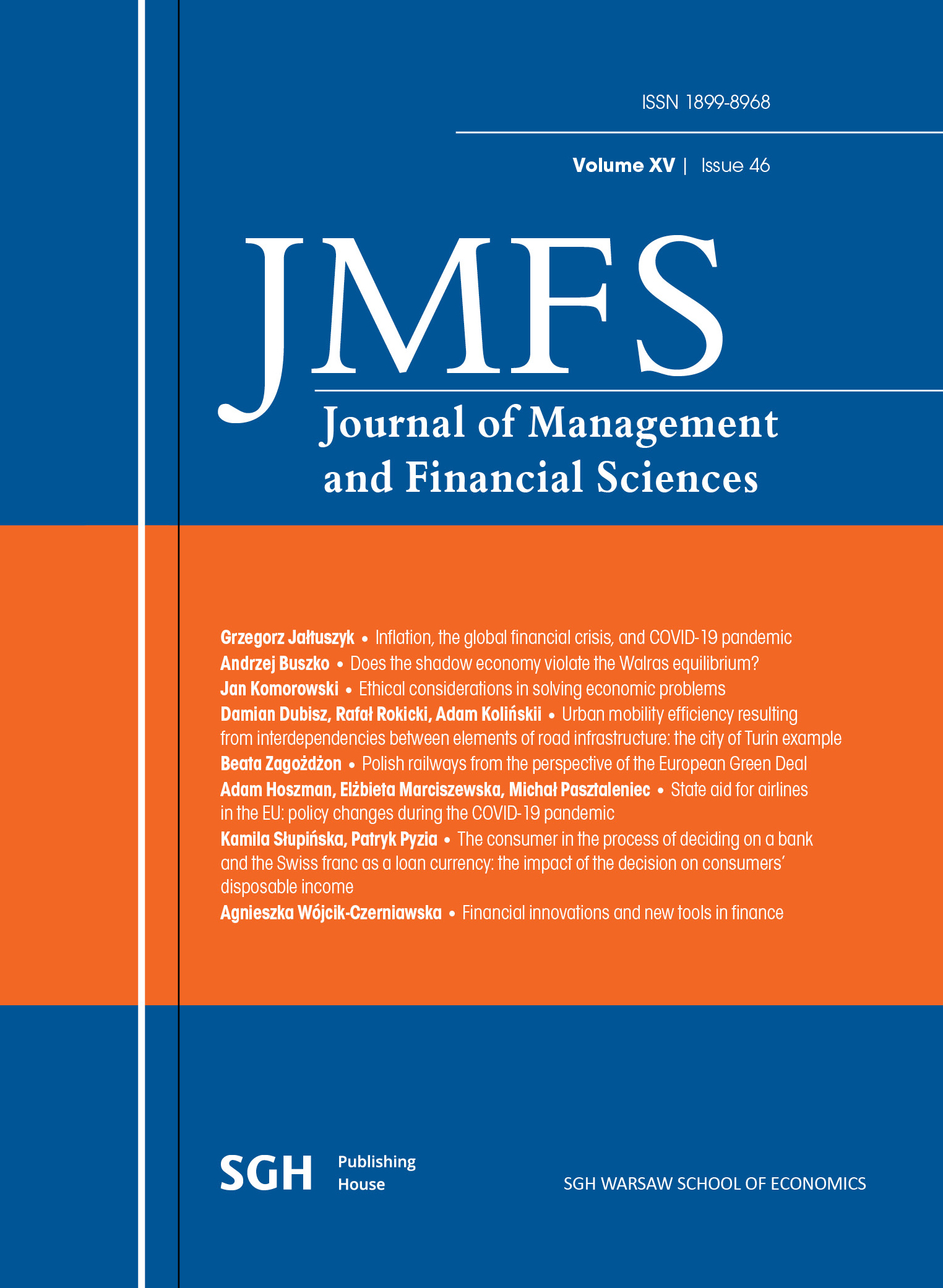Urban mobility efficiency resulting from interdependencies between elements of road infrastructure: the city of Turin example
Main Article Content
Abstract
In this study, an attempt was made to determine the interdependencies between individual parameters of urban logistic networks. As a result of the literature review, a research gap was identified indicating the lack of precise reference to the dependencies between selected road infrastructure elements. The collected information is of key importance for IT systems supporting the management of urban infrastructure in the area of Intelligent Traffic Systems (ITS). The impact of the number of lanes on average travel speeds broken down into rush hours and off-peak hours has been analysed. The conducted research allowed the authors to determine the degree of influence of the number of lanes on the road capacity and the average speed of vehicles. The results of the analyses can be used to power integrated systems for city traffic management and affect the shape of the new road infrastructure design.
Downloads
Article Details

This work is licensed under a Creative Commons Attribution 4.0 International License.
References
Baras, J.S. (2015, April 13). Model-Based Systems Engineering for Networked CPS Research and Education. CPS Summit, Seattle, WA. Retrieved from: https://cps-vo.org/node/19192 [accessed: 16.08.2022].
Buch, N., Velastin, S.A., Orwell, J. (2011). A Review of Computer Vision Techniques for the Analysis of Urban Traffic. IEEE Transactions on Intelligent Transportation Systems, 12(3), 920–939, https://doi.org/10.1109/TITS.2011.2119372
Caramihai, S.I., Dumitrache, I. (2013). Urban Traffic Monitoring and Control as a CyberPhysical System Approach. In: L. Dumitrache (Ed.), Advances in Intelligent Control Systems and Computer Science (Vol. 187, pp. 355–366). Berlin Heidelberg: Springer, https://doi.org/10.1007/978-3-642-32548-9_25
D’Andrea, E., Marcelloni, F. (2017). Detection of traffic congestion and incidents from GPS trace analysis. Expert Systems with Applications, 73, pp. 43–56, https://doi.org/10.1016/j.eswa.2016.12.018
Giuliani, F., De Falco, A., Cutini, V. (2020). The role of urban configuration during disasters. A scenario-based methodology for the post-earthquake emergency management of Italian historic centres. Safety Science, 127, p. 104700, https://doi.org/10.1016/j.ssci.2020.104700
Hart, R. (2002). Containing children: Some lessons on planning for play from New York City. Environment and Urbanization, 14(2), pp. 135–148, https://doi.org/10.1177/095624780201400211
Kamarianakis, Y., Prastacos, P. (2003). Forecasting Traffic Flow Conditions in an Urban Network: Comparison of Multivariate and Univariate Approaches. Transportation Research Record: Journal of the Transportation Research Board, 1857(1), 74–84, https://doi.org/10.3141/1857-09
Keller, M. (2019). How the road network determines traffic capacity. ETH Zurich. Retrieved from: https://techxplore.com/news/2019–11-road-network-traffic-capacity.html
Loder, A., Ambühl, L., Menendez, M., Axhausen, K.W. (2019). Understanding traffic capacity of urban networks. Scientific Reports, 9(1), 16283, https://doi.org/10.1038/s41598-019-51539-5
Monzon, A. (2015). Smart Cities Concept and Challenges: Bases for the Assessment of Smart City Projects. In: M. Helfert, K.-H. Krempels, C. Klein, B. Donellan, O. Guiskhin (Eds.), Smart Cities, Green Technologies, and Intelligent Transport Systems (Vol. 579, pp. 17–31). Springer International Publishing, https://doi.org/10.1007/978-3-319-27753-0_2
Mouronte-López, M.L. (2021). Modeling the Public Transport Networks: A Study of Their Efficiency. Complexity, 2021, 1–19, https://doi.org/10.1155/2021/3280777
Robertson, D.I., Bretherton, R.D. (1991). Optimizing networks of traffic signals in real timethe SCOOT method. IEEE Transactions on Vehicular Technology, 40(1), 11–15, https://doi.org/10.1109/25.69966
Xie, H., Gao, M., Zhang, R., Xu, H., Wang, Y., Deng, J. (2017). The subversive idea and its key technical prospect on underground ecological city and ecosystem, 36(6), https://doi.org/10.13722/j.cnki.jrme.2017.0163
Zhao, L., Song, Y., Zhang, C., Liu, Y., Wang, P., Lin, T., Deng, M., Li, H. (2020). T-GCN: A Temporal Graph Convolutional Network for Traffic Prediction. IEEE Transactions on Intelligent Transportation Systems, 21(9), 3848–3858, https://doi.org/10.1109/TITS.2019.2935152
Zhuravleva, N.A., Gulyi, I.M., Polyanichko, M.A. (2019). Mathematical description and modelling of transportation of cargoes on the base digital railway. Environment. Technologies. Resources. Proceedings of the International Scientific and Practical Conference, 2, 175, https://doi.org/10.17770/etr2019vol2.404
